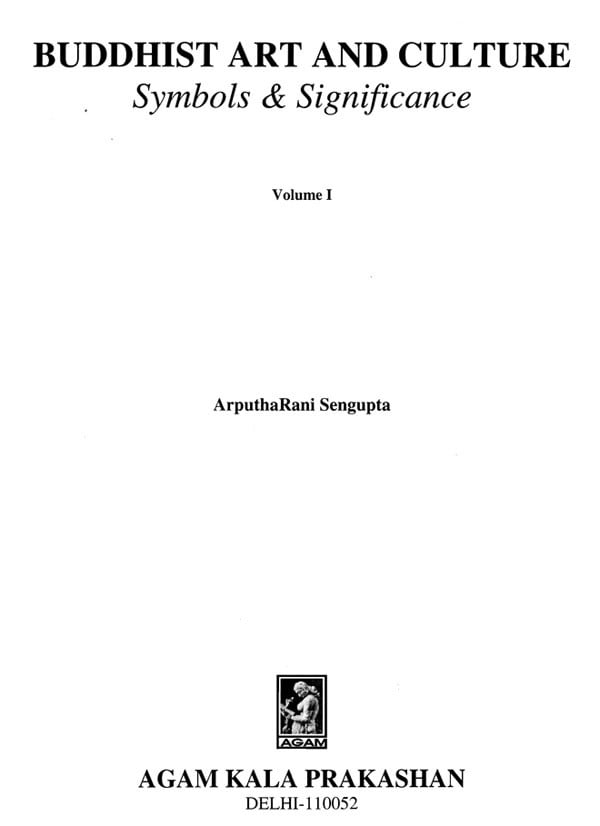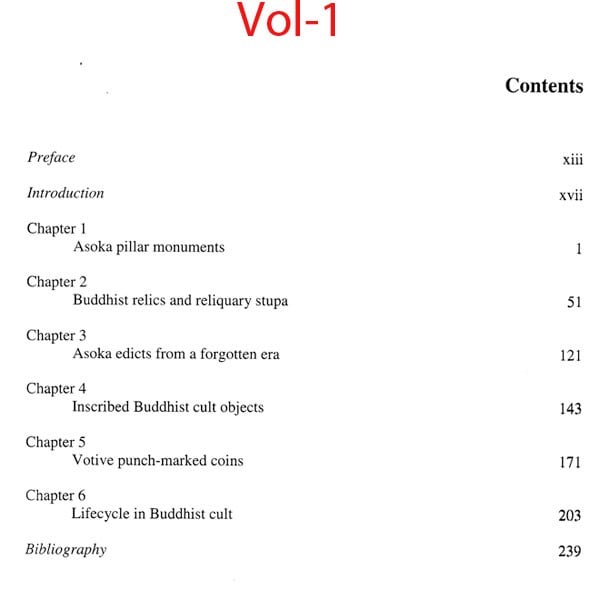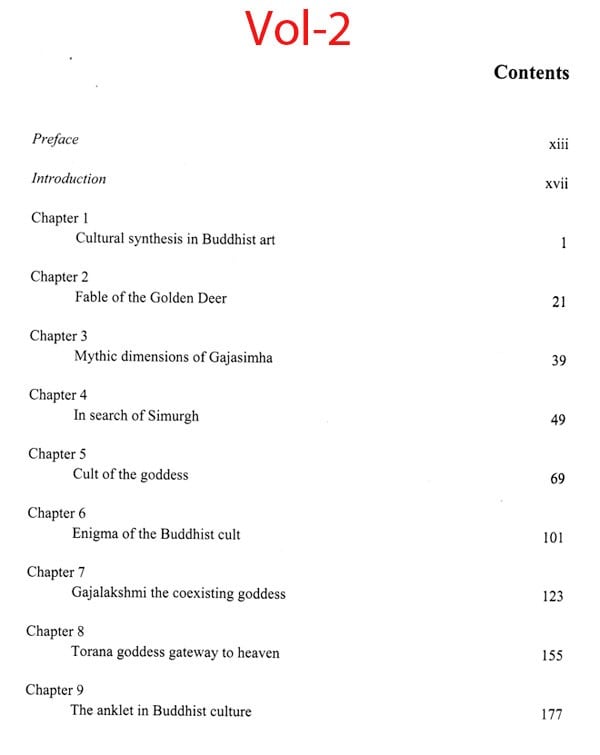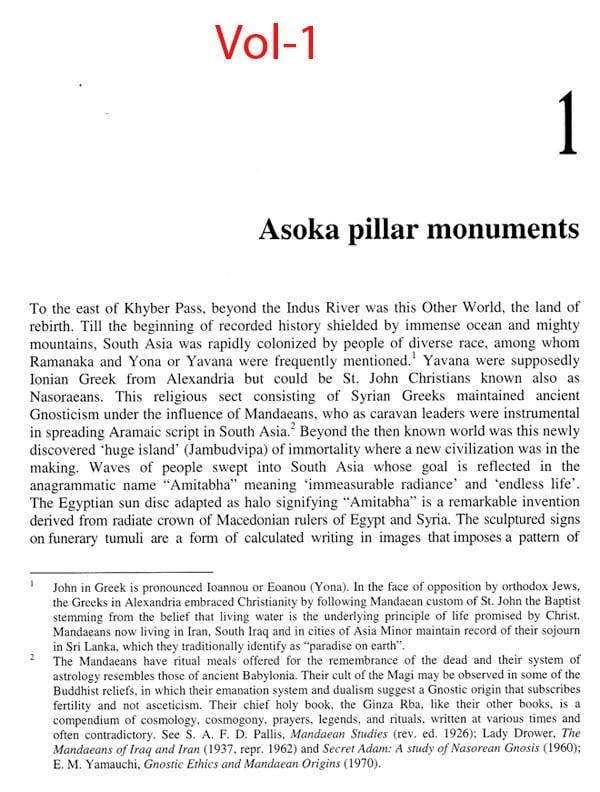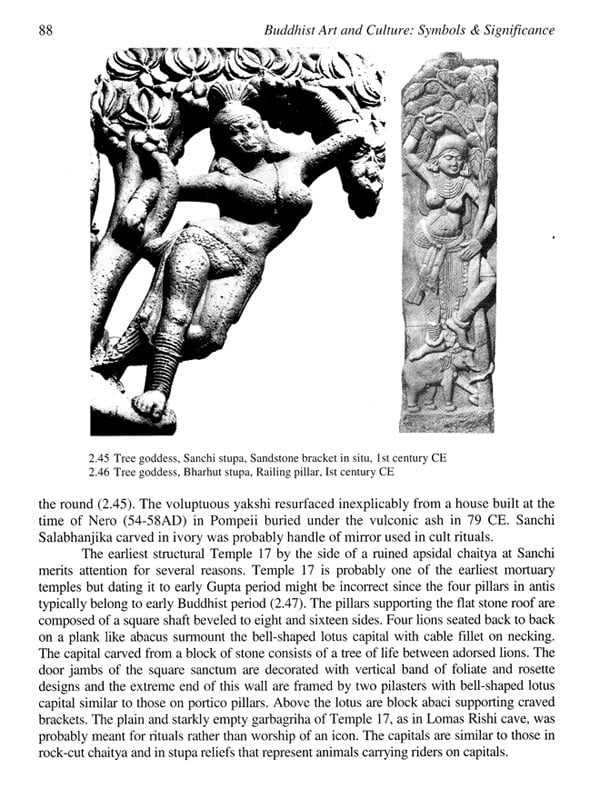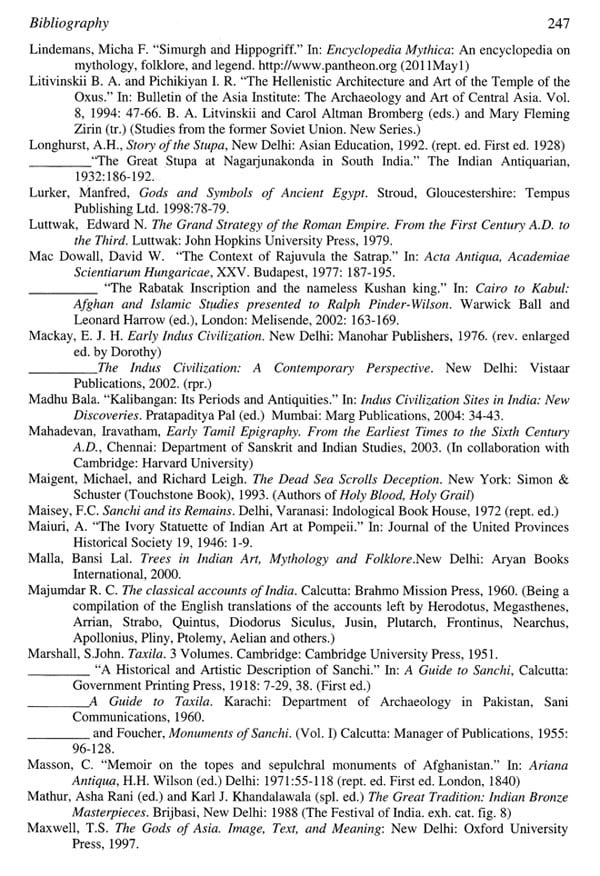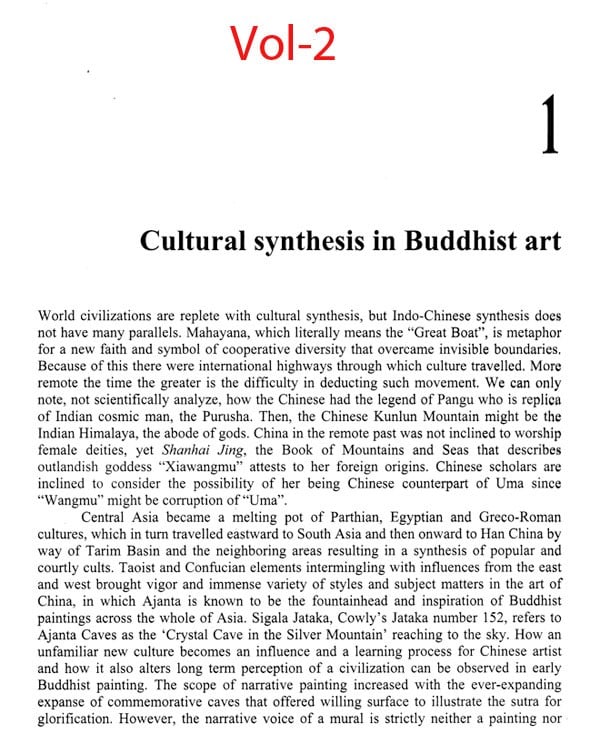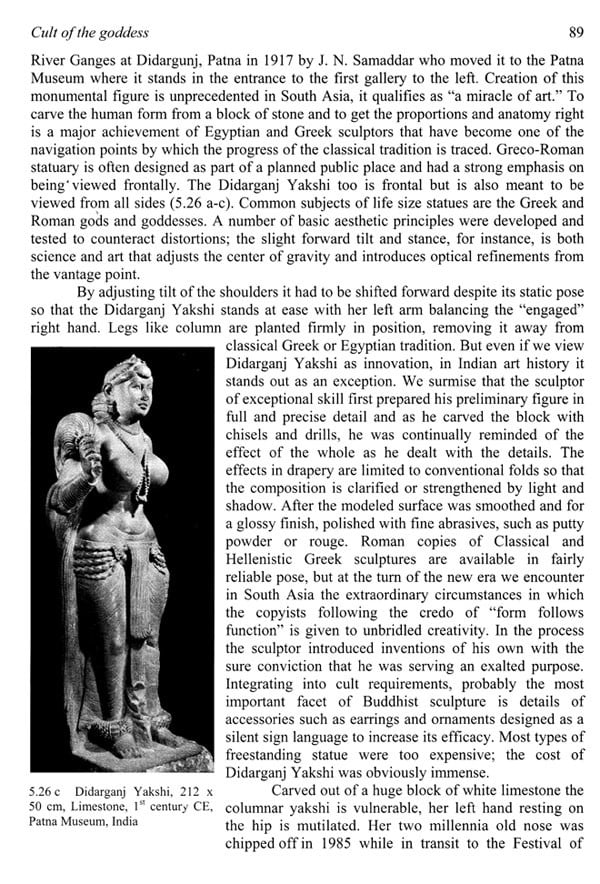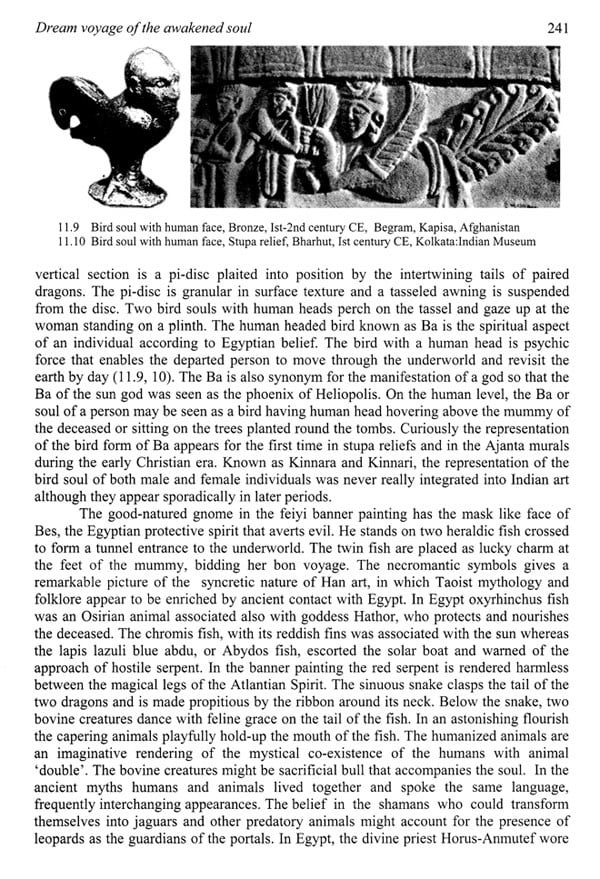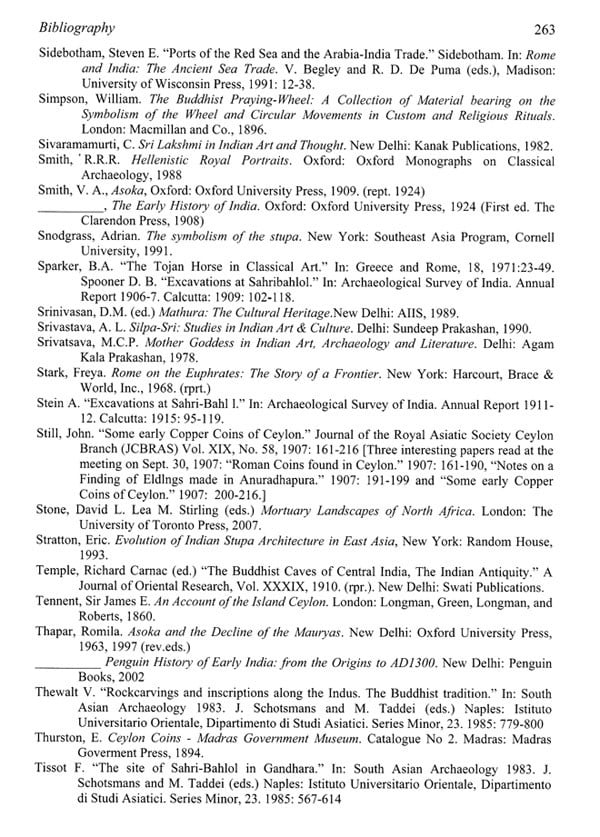
Buddhist Art and Culture Symbols & Significance (Set of 2 Volumes)
Book Specification
| Item Code: | AZH318 |
| Author: | Arputharani Sengupta |
| Publisher: | AGAM KALA PRAKASHAN, DELHI |
| Language: | ENGLISH |
| Edition: | 2013 |
| ISBN: | 9788173201271 |
| Pages: | 516 (Throughout B/W Illustrations) |
| Cover: | HARDCOVER |
| Other Details | 11.50x9.00 inches |
| Weight | 2.44 kg |
Book Description
Roman Diaspora in the making of India thrived on a syncretic goddess ushered by the Greco-Buddhist reliquary cult. Lustrated by royal elephants identified with Africa, goddess Cajalakshmi on lotus of rebirth coexists with Isis-Venus and Nemesis symbolized by the Wheel of Law (Retribution), winged griffin and other rebus memory devices. Metaphors originally distilled faith in afterlife but these necromantic signs are now translated as Buddha's external presence transla in a neural religion. Unprecedented cult images of goddess invoked as Maha Maya (Mega Maia) and Maha Vihara Devi on the Great Boat (Mahayana) radically transformed cultural landscape of South Asia. Subject to influences, meaning of art correlated with Mystery religions moved eastward from the Mediterranean to reach the gateway to heaven (Torana). The search for immortality demonstrates inter connectedness of all art objects from Gandhara to Sri Lanka giving ample scope for portraiture, narrative techniques and symbolic communication. Backed by new mortuary practices and esoteric rituals, magic of art and new Brahmi script invented from Aramaic was crucial to afterlife. Not surprisingly Tamil Brahmi on pot shards was found in Berenike and Oman. The two volumes examine Late Hellenistic synthesis in order to create new premises for investigating its Greco-Roman past centered on the powerful impulse to induce Descent of the Lord (Bhagavato ukramti) through Immaculate Conception (Dream of Maya) culminating in Miraculous Rebirth accompanied by Alexandrian situla, cornucopia and tree of life.
Art Historian ArputhaRani Sengupta (1947) examines semiotics of iconography with wide range of meaning in the South and Central Asian Buddhist cultures in the milieu of the Greco-Roman world. Her primary interest is to study the ways in which trans cultural non-linguistic phenomena in art history can generate meaning and provide information on the role of cultural synthesis and knowledge production. Her powerful deductive Alternate History is a new form of empiricism that reveals synthesis of heterodox beliefs and philosophy in the Greco-Buddhist reliquary art and cult during the early Christian era. The former Professor at the National Museum Institute, New Delhi and Stella Maris College, Chennai is adjunct faculty in the Delhi Institute of Research and Heritage Management. Sengupta has undertaken cross-disciplinary research on prehistoric and early historic burial goods in South Asia and on Buddhist Symbols and Substitutes with research grant from the Ministry of Culture and the Indian Council for Historical Research. Publications include Art of Terracotta: Cult and Cultural Synthesis in India (2004), Buddhist Art and Culture: Symbols and Significance (Forthcoming), Jewellery from Buddha Zone in Central and South Asia (Forthcoming), Kailasanatha Temple. The Realm of Immortals (2009), and Makimekalai: Dancer with Magic Bowl (2005) Edited volumes include Cult of the Goddess (2012) and Devaraja Cult in South and Southeast Asia (2004).
At the dawn of Christian era, Buddhist cult in South Asia extending into the North West Frontier Region was preoccupied with immortality and reincarnation. This book deals with Buddhist material culture in the Indo-Parthian Greco-Scythian Kushana kingdom synchronal to the Roman Empire. Contradicting philosophic and ethical code of renunciation generated by Buddhist scriptures, ritualized reliquary cult generated extraordinary mortuary art and architecture and diverse types of reliquary containers and funerary goods. Sculptured funerary monuments are dominated by Sri, goddess of beauty, fortune and love comparable to Isis-Venus-Nemesis and the Mistress of Animal personified as lion, winged griffin, cobra and several other. Surrounded by circle of voluptuous divine female inventive Gajalakshmi on the lotus of rebirth appeared for the first time in Buddhist art. The goddess lustrated by elephants is critical for survival. The numinous essence of innumerable Buddha (Gk. BODDO) united in sacred marriage resides in the womb chamber of the goddess (Datugarbha), the heart of the hemispherical reliquary stupa. What holds our attention in this line of investigation is the role of the goddess and secret communication through necromantic signs and symbols besides how the reliquary cult shaped formation of the ancient society based on its convictions and way of life. As revealed by the Universal Plan of Iconography, some of the most compelling are the lifecycle depictions beginning with Ascension to Heaven, Supernatural Conception and Miraculous Birth/Rebirth in which mother goddess Maya (Maia) in magic rituals appears with lamp, spouted situla and other cult objects of distinct Roman design. Evidently a powerful reaction must have taken place and in order to understand this upheaval, we must first consider its results in Buddhist art and then work back to determine its causes.
The danger of a single story is that it repeatedly shows the Buddha as only one thing and has thus gained power as the definitive truth irrespective of the fact that the single-story-mindset effectively blinds us to several others mentioned in inscribed reliquaries. A desire to illuminate the collective memory of Roman Diaspora in Buddhist South Asia guides this scholarship. Hypothetically, leaders of the first generation cultists were educators and felicitators with specialized skills in esoteric rituals and cult practices in which design, architecture, art and cultural field was joint project of erudite artists. For the benefit of greater understanding, the goal is to interpret visual clues with support of morphology and psychology of art. In order to create new understanding the structure of enquiry examines multiplicity and contradictions as well as arrives at how innovations and reproductions are also basis for a high quality of synergy. Material evidence indicates that the nascent Buddhist society is not bound to geography. But this kind of enquiry can be disconcerting where patriotic archaeology is concerned, for it not only shaped a society and its culture but gave its identity and created the landscape in which images hold symbolic meaning. In the fledgling Buddhist cult it is important to study the interaction between the physical and the metaphysical, and the relation between the life of a people and their physical environment, which in this case was unpredictable and fluctuating, the very reason why it disappeared as suddenly as it appeared.
Art is always situational and hence it introduces the need to replace the idea of an eternal essence of art by an approach that focuses on the context in which art is created. Role of art and memory in the process of rediscovery and reconciliation is fundamental to understanding that spotlights the birth of new humanism in response to instability in various parts of the Roman world. In the light of the links that Buddhist art had with diverse cultures we are acutely aware of unprecedented migrations and mergings in the global system of visual and verbal communication. In particular the Kushana bilingual coins in Greek and Prakrit, a local language inscribed in Brahmi and occasionally in Kharoshti script was adapted from Aramaic but designed by a Greek hand. It brings to focus what happens to portable written material in global network of communication, which is comparable to transnational cyberspace of today. Behind the communicative system developed in early Buddhist cult is the intelligence of the most 'networked brains'. The most efficiently wired brains of the period devised mass communication system based on newscript, signs and symbols developed for utmost worth and magical effectiveness. It is possible that their efficiency was enhanced by common goals supported by supreme wisdom of the ancient past that offered tantalizing means of boosting cognition. The concept of networked brain is not so different from the transportation grids used to arrive at a destination by most direct and shortest way possible, which they also successfully managed for the very first time while charting the course to South Asia. If you are sailing from Alexandria to the subcontinent at the farthest reaches of the then known world, the most efficient was to follow the course of monsoon winds to arrive first at the Persian Gulf and then to Barygaza on the west coast. It carried with it ideas that provided snap-shots of absolutely new art and architecture. The signs and symbols on the Buddhist stupa provide communication between the crossbars and posts to the towering gateways filled with several circular friezes composed by the Masonic "Rule and Compass". Like the remarkable "Ringstones" the ring of stone fencing and sculptured medallions on stupa monuments does not stay completely quiet as one might expect of a dead substance. As in the brain, the creativity representing underlying connectivity between standardized grids and circles, near and far, allowed them to build networks with every stupa complex in Central and South Asia. And through this new and vast network, the efficiency of geomancy of the grave is measured by multiple but unified voice of Provincial Rome supported by unifying Brahmi script and Iconography in Greco-Roman style expressing shared hope of renewal and the reward of ultimate glory. Thus, despite racial differences the groundbreaking Buddhist iconography unites disparate groups of peoples in a puzzling proto historic grave culture.
**Contents and Sample Pages**
